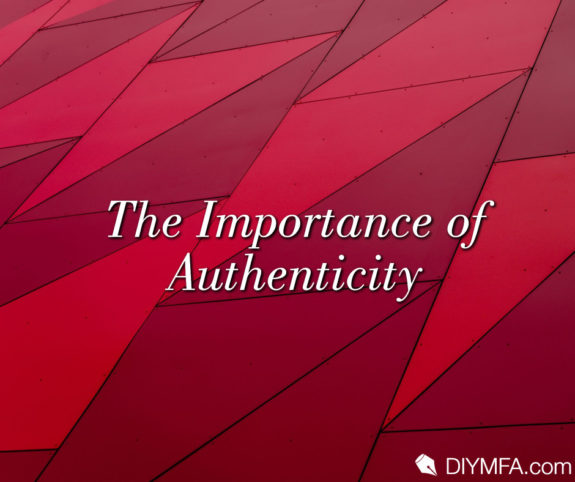The impetus for this article arose from two decidedly different sources. Late last year, an Amazon reviewer of one of my own books posted, “Alfred has sunk too low. Fidelity and loyalty are paramount in my world.” Then, a couple of weeks later, a member of the DIY MFA family posted a question on Word Nerds Unite asking about whether they could show characters smoking during World War II or if this would offend modern readers. These two posts reminded me that, even though there is a thread in this column devoted to “Creating Authentic Details,” those articles speak more to specific types of historical details than to the overarching question of authenticity in our genre.
A Matter of Authenticity in World-Building
Authors who write Fantasy are constantly reminded what a critical element world-building is in the development of their narratives. Readers need to understand the imaginary world they’ve created – its geography, social hierarchy, cultural morés, politics, economics, justice system, weaponry, values, religious beliefs and practices – and, in some cases, a system of magic. But we must still write with authenticity. Character behavior must align with the rules of this world. As often as not, characters will be thrust into interactions with a second world as part of the narrative conflict – and that second world must be revealed to readers through the eyes of the characters. It’s a lot of responsibility for the author to ensure consistency.
In historical fiction, we have the same need for authenticity. It is our responsibility. We must recreate a world that once existed but that may be substantially different from what readers are living today. In some respects, we have an advantage – there’s documented evidence of what this once-upon-a-time world was like, so we don’t bear the responsibility of making it all up from whole cloth. And we may have another small advantage in the fact that our reading audience may already have some degree of familiarity with the world in which our story is set.
But it’s no less important that we paint that world accurately and that our characters behave in a manner that aligns with the world in which they actually lived.
When Worlds Collide
Both of my prompts are manifestations of the same issue – the question of whether writers should cater to readers who might project their own world onto the story we’ve written.
In the case of my reviewer, it’s quite explicit from the phrase “are paramount in my world” that this is exactly what the reader is doing. But Alfred’s actions took place in his world – the world of the 14th century – not in the reader’s world. The case of the question about smoking during the 1940s represents a writer tempted to omit an important reality of their story’s world just to cater to modern views.
It’s inevitable there will be disharmony – sometimes even strong discord – between the past and the present. Just as medicine has advanced such that we can easily treat or even eradicate diseases that would have been deadly in bygone days, so has human understanding evolved in areas as diverse as criminal justice, societal responsibility, governance, human rights and self-determination, cultural awareness, commerce, education, conflict and weaponry, scientific exploration, physical and mental health, stewardship of our planet . . . just to name a few. Still we must strive for authenticity in our writing.
Throughout history, our moral compasses have pointed north. But just as the Earth’s own axis of rotation precesses over time, so has moral north shifted through the centuries. What was considered normal at one time in human history might be viewed as ignorant, or perhaps heinous, today. Beheading was once considered a merciful form of execution (compared to the more brutal alternatives), but it wouldn’t be viewed that way today. People who claim to “hear voices” have been with us from time immemorial. In the past, they might have been considered “possessed by the devil,” “hearing the voice of God,” “practicing witchcraft,” or just plain lunatic. Today, we’d be more inclined to investigate a possible diagnosis of schizophrenia or other mental illness. The mechanism by which a baby’s gender is determined wasn’t understood until the early 20th century, which meant all sorts of notions flourished at one time or another and made it easy for men to blame their wives if the couple didn’t produce a male heir (often with horrific results). Today, we know better. And we can show how we know better by providing these details with authenticity.
As writers of historical fiction, we have a responsibility to reflect the world as it actually existed at the time of our narrative. We wouldn’t attempt to cleanse beheading from stories of Tudor England or the French Revolution. We wouldn’t represent Joan of Arc as mentally ill, though who knows if perhaps she was. Nor would we deny that Henry VIII blamed two of his wives for failing to give birth to sons or the anxiety felt by women in general over what they considered their responsibility to deliver an heir.
Likewise, we’d be doing readers a disservice to pretend that smoking wasn’t prevalent in the 1940s – both as a popular form of stress relief and as a social convention. And in my own stories set in the 14th century, pretending that men didn’t seek female companionship outside marriage would be equally dishonest.
But What About the Really Bad Stuff?
What about things like the subjugation or even annihilation of indigenous people by colonizers? What about the African slave trade? What about abuse of workers and child labor during the Industrial Revolution? What about “supremacist” movements of all sorts from the Crusades to the Ku Klux Klan to the “Japanization” of Korea in the first half of the 20th century to the Holocaust? What about torture? What about _______? (fill in the blank). Does writing with authenticity mean leaving these details out?
History is full of atrocities that are in conflict with modern sensibilities. Many of our stories will never come into contact with the worst of the worst. But when a story unfolds against the backdrop of something modern readers may find offensive, what’s a writer to do?
In the next post for this column, we’ll explore some strategies for bridging the discord between the realities of the past and modern sensibilities.

An award-winning author of historical fiction and a freelance editor, Pamela Taylor loves helping others polish their stories almost as much as she enjoys writing her own. She’s a member of the DFW Writers Workshop and the Editorial Freelancers Association and is in her fourth year on the judges panel for the Ink & Insights Writing Contest. She shares her home with two Welsh Corgis who frequently remind her that a dog walk is a great way to get inspiration for that next chapter.







